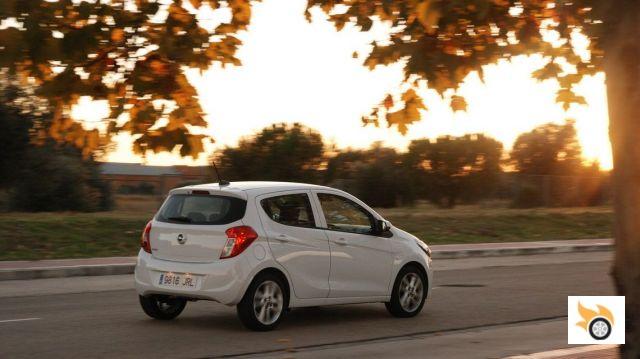Opel had the Agila, developed in collaboration with Suzuki. However, the small minivan format design did not fit with the tastes of the old continent. With the Adam, Opel was more successful and the acceptance of this model in the market is more than reasonable thanks to its enormous possibilities for customization and good finishes, although, for price, we can not label it as a bestseller. Filling the gap of the Agila, the Karl becomes a very interesting option within the A-segment for those who want to maximize their investment.
It's spacious, comfortable, quiet, well-equipped and, above all, economical to buy and maintain.
For just over a week I have had the opportunity to drive a unit of the Karl and I must admit that it has left me very good impressions, much better than I thought at first. It may not be the most rounded model in the segment, but it is one of the few truly reasonable ones, giving a lot for very little. There is only one Opel Karl and this is it. It does not exist with other body types, there are no other engines available or more finishes. It is a car that either take it or leave it, with the exception of being able to choose the color, the type of transmission and some optional equipment. Its positioning is eminently urban, very practical and easy to use.
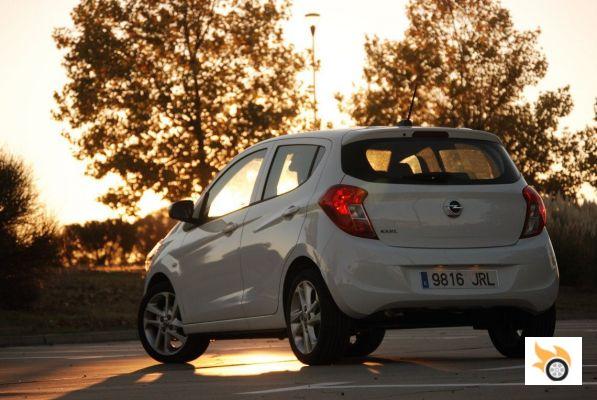
Before we start with the description of the car, let's remember some general information.
Why is it called Karl? Like the Adam, the name Karl also comes from the Opel family, specifically the eldest son of Adam Opel, founder of the brand in the distant 1863. It is manufactured at the General Motors plant in South Korea, along with its cousin, the Chevrolet Spark. However, "it is developed by engineers and designers of the brand," says Neumann, the brand's president. It certainly has a family feel to it.
It is a five-door, five-seater passenger car. Here we have to give Opel a +1 because some of its rivals, like the Seat Mii, are only approved for four passengers. Having ridden in the Karl just after riding in an Adam, I have to say that it's much more spacious and versatile inside than you'd expect, considering it's only 3.6 meters long. Although, in exchange for that large cabin space, the boot is a modest 206 litres.
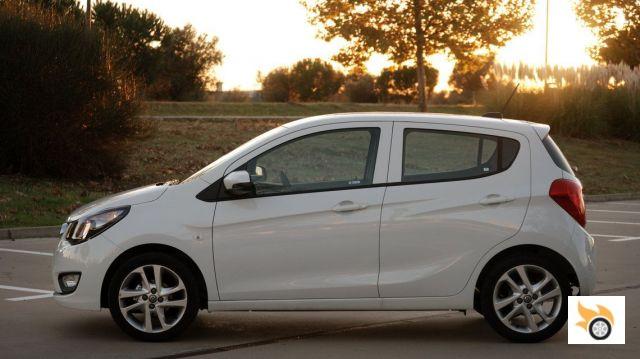
Design
The exterior is simple, perhaps we could even classify it as sober if we take a look at the competition. Despite this, its silhouette, without stylistic boasts, is pleasant and harmonious.
The front has the family traits. And I mean traits because it's not a miniature clone of its big brothers. Unlike other brands, the Karl can be distinguished from a Corsa or an Astra. The large front grille with the centered lightning bolt logo stands out. The chrome extends with "wings" that go from the emblem to the ends of the grille, without touching the end of it. Elements such as the headlights and fog lights have that air that make you think that this is an Opel.
Seen in profile is simple and does not produce a negative visual impact. Play with the stamping of the doors and side ribs upward to create a sense of dynamism. All elements of the body are painted, making it not give the feeling of being a "low-cost" car. The rear is the least changed with respect to its American twin, just the brand logo and the position of the license plate holder.
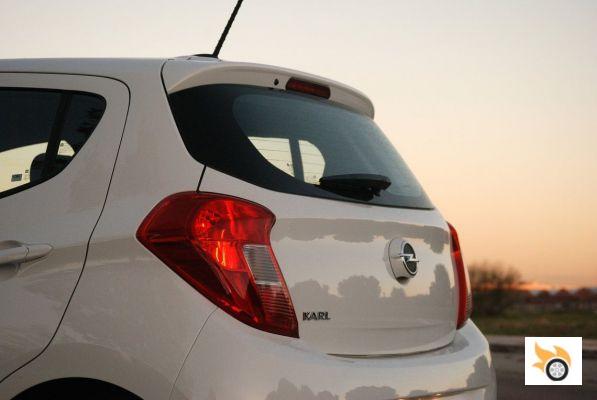
The vertical pilots are generous and leave a lot of sheet metal in sight, giving the feeling of being a robust car, but not ugly. To see the exhaust outlet you have to bend down a bit, as it is located behind the short rear bumper. Given that in Spain is only marketed with a single level of finish is complicated to change much the appearance. The choice of the 16" wheels (like the ones on the tested unit) instead of the 14" sheet metal ones, improves the car's image somewhat.
In Opel's options catalogue you can equip it with folding tables behind the rear seats, a coat hanger or an iPad holder on the headrest. You can also order Opel door sill trim, stainless steel pedals for the manual transmission, wheel skirts, body-colored side moldings and a trunk lid with anti-skid surface.
Other than that little else. If you want more customization options it is better to discard this model. Compared to the Agila, the Karl is 7 centimetres shorter (3.67 m) and 12 centimetres lower (1.47 m). The width has hardly changed (1.60 m). Although it is shorter than its predecessor, the wheelbase has increased by just over 3 centimetres (2.38 m).
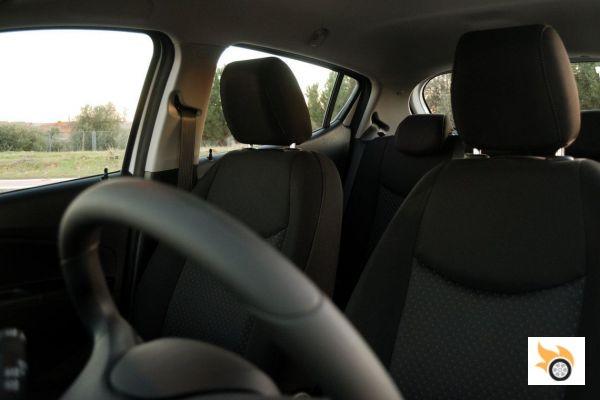
Cabin
The first thing to note, although I think I've said it before, is the space on board. It's incredibly spacious for how small it is. In fact, there's more legroom in the rear seats than in some larger cars, such as the Volkswagen Polo and Peugeot 208. Headroom in these seats is not a problem either, neither in the front nor in the rear, for people up to about 1.85 metres tall. Logically, behind, the level of width does not stand out so much (three adults fit, a little tight, but fit).
It should also be noted that, once mounted in the car, especially in the back, it doesn't feel cramped despite having a relatively high waistline. And that's because the rear windows are wide and the rear seat itself is located in a high position. By the way, the rear windows are traditional style, with a crank, but they go all the way down. Isn't vintage in fashion now? Fortunately, the front windows are electrically operated, although if you want them all the way down you'll have to hold the button down, as they don't have a "one-touch" function. And if for some reason you've left them down when you get out of the car, you'll have to get back in and press the ignition to raise them.
The rear seats have a fairly vertical backrest, so it could become uncomfortable if you stay many hours back there. The front seats are comfortable and well cushioned, with a good cushioning. The driver's seat can be adjusted both in height and depth. The same cannot be said of the steering wheel, which lacks this last option and can generate some discomfort in some users, forcing them to stretch their arms or shrink their legs.
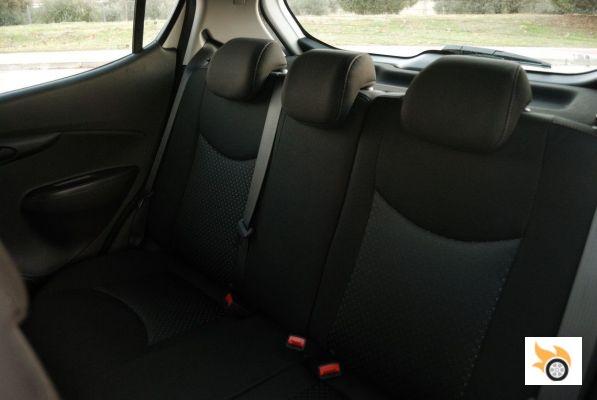
The rear seats fold down 60/40, but not to the point of making the back completely flat. In any case, without them you have 1,013 liters of capacity and with them the 206 liters in which fits perfectly the week's shopping or luggage for a weekend. A somewhat high and narrow load mouth can bother us when it comes to putting large objects. Under the (very) subtle carpet in the boot there's room for an emergency spare wheel, but as standard you'll have to make do with a puncture repair kit. A decision linked to cost savings but unattractive to users.
Once we are seated in the car and close the door, we notice that it closes the first time with little effort and does not sound tinny, giving the feeling of a well-built car. The first thing we see is the dashboard and instrumentation with a fairly nice presentation. It is true that the materials are not top quality by far (all plastics are hard), but there is no sheet metal in sight, there are no sharp edges and all controls have good touch (inherited from their older brothers).
This is a reasonably priced car, but there is not much justification for the lack of roof rails in all seats or the lack of storage space in the rear, as there are no bags behind the front seatbacks or door pockets. On the other hand, in the front seats there are bags in the doors and you can also leave objects under the console. When the boot is opened, the luggage tray remains fixed because there are no cords to connect it to the boot and the tailgate lacks any covering.
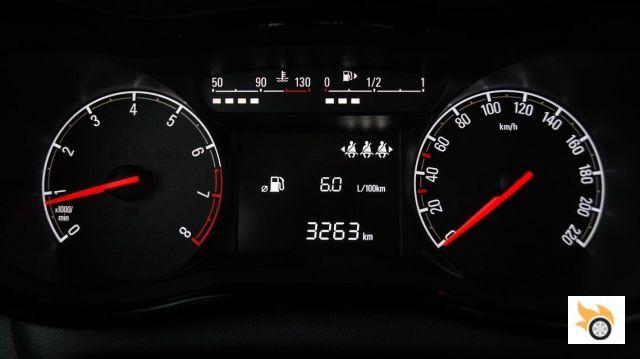
Details such as a glove box with a rubberized floor, interior light dimmer adjustment or a small courtesy light in the recess where the 12V socket and USB port are located, make some of its shortcomings go unnoticed. The instrumentation is well presented, easy to read and with a very complete on-board computer. There are two analogue dials for the tachometer and speedometer, while the fuel level and engine temperature are measured by means of small squares above the on-board computer.
Even the tyre pressure can be read in real time.
The infotainment system is perhaps the highlight of this little guy. Opel is especially proud of its touchscreen, which thanks to its powerful processor should always work very smoothly and stably. After several days of driving it I have to say that I find it one of the fastest, smoothest and most intuitive screens I've ever tested. This screen comes with the "Techno Pack" which, in addition to the 7" screen with R 4.0 IntelliLink system, brings Opel OnStar, offering an application for remote control of the car, assistance in case of theft of the vehicle, automatic response in case of collision, vehicle diagnostics, downloading the itinerary or Wi-Fi connection throughout the car.
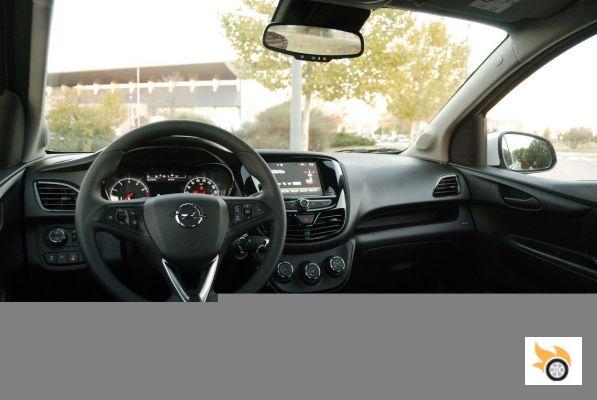
It can be operated by finger, steering wheel or voice, and is compatible with smartphones with Android (Android Auto) and iOS (Apple CarPlay) operating systems. If your mobile phone is compatible with this system, you'll get a lot out of the multimedia system. For navigation, IntelliLink opts for the BringGo app, which offers 3D maps of Europe and real-time traffic information (using the 3G/4G connection on your mobile phone). If you are worried about the data consumption of your mobile phone and its battery you have nothing to worry about. Remember that to access Apple CarPlay or Android Auto services your smartphone will have to be connected to the USB port (which will charge the battery) and, in the case of using navigation, you will use the car's Wi-Fi connection.
4G LTE Wi-Fi and OnStar are free for a while, then you have to pay for them.
One thing to note: if you're a social media obsessive, you should know that once your phone is connected, all notifications will be muted and the "Hey Siri" function for Apple devices will be disabled. Of course, IntelliLink also has a CD player, MP3/WMA player, USB connection, functions for receiving and sending calls via Bluetooth, and lets you view photos (jpg, bmp, png and gif formats) and even videos (avi, mpg, mp4, divx, xvid and wmv) on your screen, as long as the car is not in motion.
Overall, the interior of the Karl doesn't disappoint at all. It's true that with other trim levels and some details that could be improved it could gain in packaging, but when the price factor is decisive, this is something that takes a back seat.
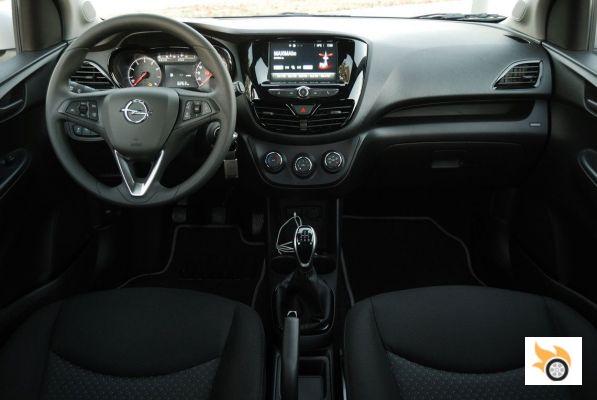
Equipment
As I said lines back, the Opel Karl is only available in one finish and one engine since it landed in our country back in the distant July 2015. Since this year, you can choose as an option the IntelliLink system (as standard it equips a CD/MP3 player with USB port and Bluetooth in 1 DIN format) and the five-speed Easytronic robotized gearbox.
But what do you get for a base price of 9,872 euros? Well, a small city car with five doors, five seats, air conditioning, electric front windows, central locking, heated mirrors, multifunction steering wheel, trip computer, CD MP3 radio, bluethooth, USB port, hill start assistant (automatically holds the brakes for three seconds to start the car without it falling backwards if it detects a considerable slope), cruise control, ABS, ESP, "City" mode for the steering, 14" steel wheels with hubcaps, etc...
Optionally there are two packages that are very interesting. The Selective Plus Pack (490 euros) features rear parking sensor, fog lights, lane departure warning, 16" alloy wheels and 195/45 R16 tyres. The Techno Pack (450 euros) includes Opel OnStar service and IntelliLink system with 4G Wi-Fi.
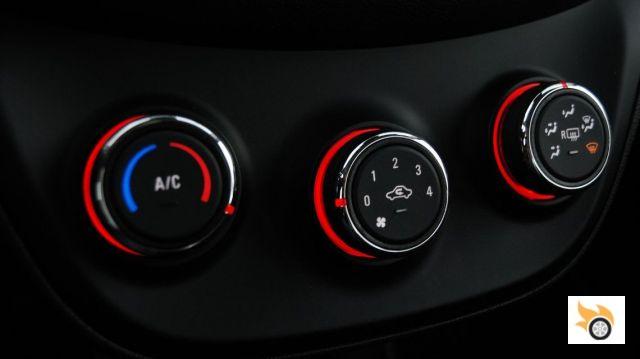
In addition to these packages, optional extras include the possibility of equipping the Karl with panoramic sunroof (600 euros), tinted windows (200 euros), rear parking sensor (160 euros), lane departure warning (230 euros) or a 14" spare wheel (60 euros). The Easytronic automated gearbox has a surcharge of just over 500 euros.
For just over 11,000 euros you can get the car fully equipped (without discounts).
What could we miss? Well, perhaps some less important details such as a leather steering wheel, automatic climate control, reversing camera, electric rear windows or light and rain sensors. All these options are possible in this car, but not in Spain. In fact, in other markets where winters are colder, such as Germany, you can even have heated seats and steering wheel.
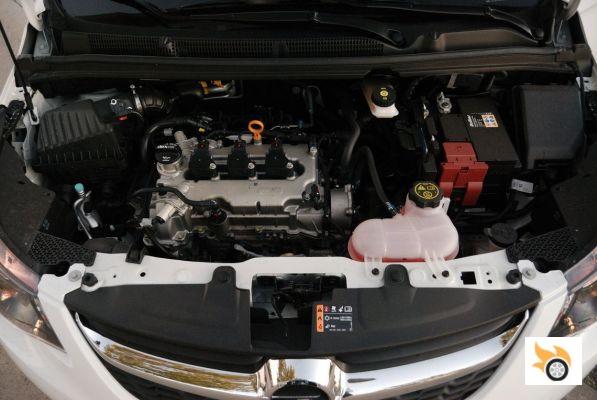
Technical
The only engine available is a three-cylinder petrol engine with 999 cc displacement, 75 hp power and 95 Nm of maximum torque at 4,500 RPM. It's basically the same 1.0 Turbo engine as the 115 hp Opel Adam, Corsa and Astra, but without the snail, and using an indirect injection system. As expected, performance figures are quite modest: 0-60 mph is covered in 13.9 seconds and the top speed is 170 mph. In fourth gear, 80-120 km/h takes about 16 seconds, while in third gear it takes about 12 seconds.
These figures are more than enough for a car in this segment and, given that it has to move a weight of just 900 kilograms (864 kg without driver and with a full tank to be exact), more power is not lacking in normal conditions, although you have to think about overtaking on conventional roads and play a lot with the gearbox adapting to the unevenness of the asphalt. In fact, the gears that will be used the most if you want a decent engine response will be third and second. If necessary the revs can be stretched up to 6,500 revs but in the upper range it doesn't rev as well.
Contrary to the usual trend, the small three-cylinder is not hidden under a plastic casing, but proudly displays its twin overhead camshaft cylinder head. The only thing this block doesn't have is Stop/Start. Taking into account its small displacement and fine-tuned management, it has been judged that the increase in weight and complication of the reinforced starter motor, its management, and the larger capacity battery, do not compensate to achieve a minimum economy in times of stop in heavy traffic. The explanation is good, but it is curious that in other markets this system is offered.
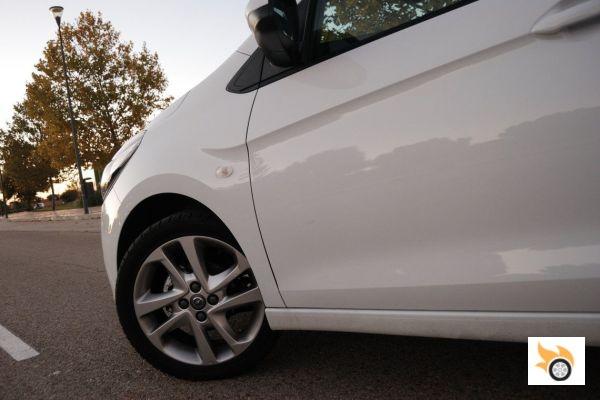
However, a limited displacement and the absence of turbo have advantages in terms of consumption. The homologated consumption is 4.5 l/100 km which, as you can imagine, in everyday life is nowhere near that figure unless you're a "hypermiler". Even so, the Karl gets under 6 litres without any problem on the road if conditions are favourable and only goes up a litre more in demanding conditions.
In the city it can get between 7 and 8 litres depending on traffic density and your pedal skills. During the 585 kilometres of the test, at an average speed of 39.7 km/h (many of those kilometres were in the city and in traffic jams), the average fuel consumption was 5.9 l/100 km. I have to admit that I tried to drive as efficiently as possible, although I won't deny that I also allowed myself the luxury of putting my foot down a bit from time to time.
I was negatively surprised by the tank capacity, only 32 litres.
Reading around, I found out that there were 12 liters more, up to a total cubic capacity of 44 liters, but, for a matter of safety camera, in the tank there is 27% less than the real capacity. That's almost 200 km of range on the road! One thing to praise about this little Opel engine is how well refined it is mechanically speaking, with a really low noise level and very few vibrations. In my opinion, it's a better engine than Volkswagen's 1.0 MPI, which my colleague Javier tested in a Polo not long ago.
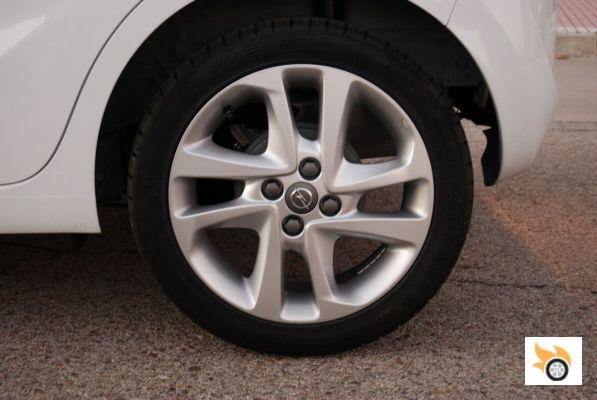
It doesn't have sound insulation on the bonnet and the block is really close to the passenger compartment, and yet it's quieter than some engines with more cylinders. Neither in town, nor on the highway, nor in sport driving is a noisy car. In fifth gear it reaches 100 km/h at 3.000 RPM and it reaches 120 km/h at 3.500 rpm and you can hear more rolling and aerodynamic noise than anything else. If you want to hear the engine well, you'll have to turn it up from 3,500 rpm. It's not that it's as smooth and with the sound of a V12, but the truth is that the sound at high revs is even nice, and I'm not the only one who thought so.
The power delivery is... very progressive and quiet, but it responds surprisingly well at low revs. At least in an urban environment, you don't need to rush through the gears to get proper acceleration. Moving on to the transmission, the 5-speed gearbox has a very precise feel to it and conveys a sense of quality. Colloquially speaking, the knob is cool, it has almost perfect ergonomics.
The front suspension is of the McPherson type with coil spring, while the rear suspension has a torsional element (rigid axle). The latter is mounted in front of the wheels, which allows the car to tend to stick a little more to the ground than some of its smaller rivals and with a level of comfort above the segment average. The tyres fitted to this unit were 195/45 R16, both on the front and rear axles. Inside are ventilated discs on the front axle and drums on the rear which, by the way, are more than adequate.
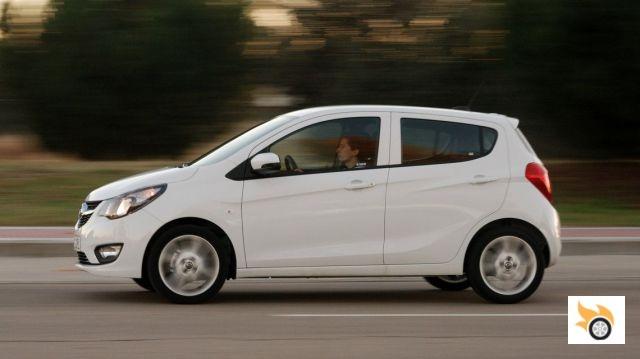
Driving
I picked up the car with less than 3,000 km on the odometer, which is practically new. The Opel Karl has proved in the test days that it is valid for all types of use as long as you take into account the limitation of its mechanics, something fair if you load the car to the top (with five people on board for example). Except for this, it more than fulfills its mission of transport.
Perhaps what cost me the most during the first kilometers was to adapt to the feel of the clutch pedal, very long travel and very soft. As it has so little torque and is naturally aspirated, starting from a standstill means compensating with a little gas, giving perhaps a little pull as soon as it reaches 2,000 turns as if it had a mini turbo. Like everything in the end, it's a matter of getting used to it.
But not only the clutch is smooth, so is the steering. It has a standard "City" mode for the power steering, whose switch is located under the light control to the left of the steering wheel, which softens it even more. This system is inherited from the days of the joint-venture with Fiat and parking manoeuvres can literally be done with one finger. However, the steering feels so power-assisted that it becomes excessively soft, slimy; it becomes imprecise.
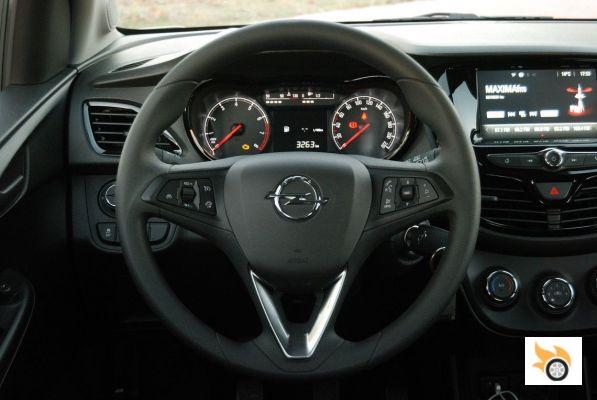
My advice is, barring parking maneuvers (and if that), don't use it. Already the steering in "normal" mode is quite smooth and easy to handle, although it offers hardly any feedback to the driver of what's happening between the wheels and the asphalt. With a turning radius of 9.5 metres between kerbs, manoeuvring can be done in very little space. It does not vary much with respect to its predecessor although it improves it (9.6 m), a normal value among its alternatives.
And is that the urban environment is the favorite of the Karl, where it shines for good visibility (failing a little in the rear pillars, where the glazed surface is somewhat reduced by the shape of the windows), good maneuverability and a sufficient engine to face slopes and leave with dignity of the traffic lights without having to bleed us the pocket to maintain it. Its good response at low revs makes it possible to use high gears and thus save some gasoline.
As I mentioned in the technical section, the feel of the gearshift lever is very well achieved because the travels are not too long and the gears are inserted with precision and with little effort. The gear staggering has two very open jumps in the first three gears (1.95:1 and 1.57:1), and two very close ones (1.26:1 and 1.25:1) between 3rd and 5th. On the open road it's fine, but in urban traffic this very open jump between 2nd and 3rd can be a bit annoying because it either over-revves in 2nd or runs out of power in 3rd. Let's not forget that it's a naturally aspirated engine of only one litre displacement.
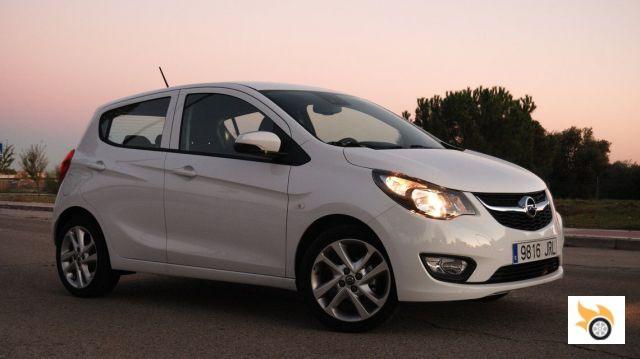
On the open road is a car that also defends itself quite well. It doesn't give the feeling of being in a "latamobile", but quite the opposite. At legal rhythms it feels a safe and stable car; it doesn't seem to be so small. The most noticeable downside is the rolling and aerodynamic noise that creeps into the cabin, being from 120 km / h somewhat annoying. Where I noticed it most was on the M-50, where the type of asphalt, expansion joints and the limits of 100-120 km / h make you can appreciate this phenomenon not paranormal.
The test unit was equipped with the involuntary lane change system. I find it totally dispensable. The most appropriate word to describe its operation is probably mediocre, because it works a bit when it feels like it, and sometimes it doesn't even warn you. It emits a beep that is barely audible (due to the noise that creeps into the cabin at high speeds) while a light on the instrument panel illuminates and is not very visible. With very basic suspensions, like those of all its rivals, but well balanced, the Karl has a good behavior. The reactions are always predictable, it transmits confidence to the driver and in the strong supports it doesn't break down or sway a lot.
It's true that when you have to tackle tight corners, it does swing a bit too much and doesn't recover quickly, but it's not a car designed to devour corners at breakneck speeds.
Despite this, the chassis seems to be more than enough in relation to the power available; it could take more horsepower. In fact, its Yankee cousin has a 1.4 of 98 hp. It would be interesting to see an OPC or GSi version of this small city car. As a result, it handles well in turns and drives with remarkable pleasure, it can bring a smile to your face. When it comes to long journeys it has a suspension set-up that allows us to cover many kilometres without our body suffering for it. The irregularities are well filtered and, together with comfortable seats, make the Karl a true multipurpose car.
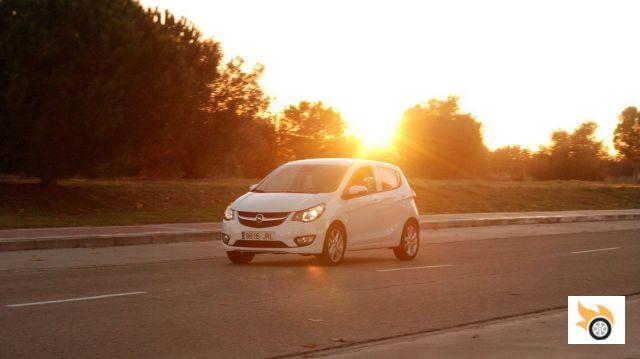
Conclusions
General Motors has a good platform for its smaller cars, Opel has managed to adjust and use it very well according to European tastes.
Its handling is simple, its controls clear. It does not require high sophistication even with all the equipment it carries, you learn to use everything in a few minutes, especially the infotainment system. Systems that sometimes it costs a little to do a little to them; in this everything is very intuitive, even for the most denied to the technologies. It is not necessary to have to be resorting to the user manual where finding everything is a mess and everything is very repetitive, as if one were short. And that's something to be thankful for in a modern car, where being computer literate is more useful than anything else.
The value for money of the Opel Karl is one of the best on the market, combining a low cost of acquisition and maintenance with a very complete equipment. The interior is spacious, the boot is reasonable, the engine uses little fuel and its refinement is sublime for a small three-cylinder. The behavior is convincing, being neutral and easy to drive as well as comfortable.
The fact that the range in Spain is so small limits the possibilities of equipment and customization that are so fashionable now. And that may put many buyers off. It's a car. A simple and friendly car that will offer you a lot for little and will take you wherever you want with a smile on your face without probably disappointing you. Anyone who appreciates everything it has to offer and doesn't attach particular importance to its shortcomings will find the Opel Karl a car with more than enough nuances and excitement for everyday driving.
